
Cyanothamnus anemonifolius, commonly known as narrow-leaved boronia or sticky boronia, is a flowering plant that is endemic to south-eastern Australia. It is a shrub with mostly pinnate leaves, with white to pale pink four-petalled flowers in leaf axils.

Boronia barkeriana, commonly known as Barker's boronia, is a plant in the citrus family, Rutaceae and is endemic to eastern Australia. It is a shrub with ground-hugging branches, simple, toothed leaves and bright pink, four-petalled flowers.

Cyanothamnus coerulescens, commonly known as blue boronia, is a plant in the citrus family, Rutaceae and is endemic to southern Australia. It is a small, spindly shrub with glandular stems, small, more or less cylindrical leaves and blue to pinkish mauve, four-petalled flowers. There are two subspecies endemic to Western Australia and a third that also occurs in three eastern states.

Boronia filifolia, commonly known as the slender boronia, is a plant in the citrus family Rutaceae and is endemic to south-eastern Australia. It is a slender shrub with simple or pinnate leaves and pale to deep pink four-petalled flowers.
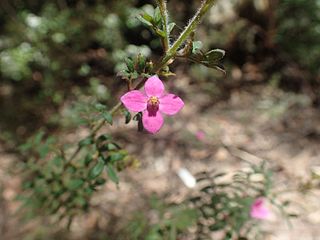
Boronia gracilipes, commonly known as karri boronia, is a plant in the citrus family, Rutaceae and is endemic to the south-west of Western Australia. It is an erect, spindly shrub with compound leaves and pink, four-petalled flowers.

Boronia grandisepala is a plant in the citrus family Rutaceae and is endemic to northern parts of the Northern Territory. It is an erect shrub with elliptic leaves and white, pink or burgundy-coloured, four-petalled flowers.

Boronia heterophylla, commonly known as red boronia or Kalgan boronia, is a plant in the citrus family Rutaceae, and is endemic to the south-west of Western Australia. It is an erect, slender shrub with trifoliate leaves and deep pink to red, four-petalled flowers arranged singly in leaf axils.

Boronia lanceolata is a plant in the citrus family Rutaceae and is endemic to northern parts of the Northern Territory and Queensland. It is an erect shrub with many branches, elliptic to lance-shaped leaves and white or pink, four-petalled flowers. It is the most common boronia in the Northern Territory.
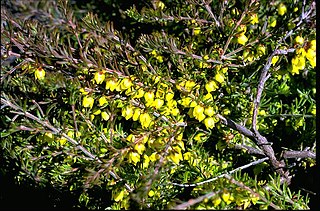
Boronia purdieana is a plant in the citrus family, Rutaceae and is endemic to the south-west of Western Australia. It is a shrub with pinnate leaves and yellow, four-petalled flowers arranged singly in leaf axils.
Boronia barrettiorum is a plant in the citrus family Rutaceae and is only known from two populations growing north of the Prince Regent River in the Kimberley Australia region of Western Australia. It is an erect, open shrub with hairy branches and leaves, simple or trifoliate leaves and white, four-petalled flowers.
Boronia cremnophila, commonly known as the Kimberley cliff boronia, is a plant in the citrus family, Rutaceae and is endemic to a small area in the Kimberley region of Western Australia. It is an erect or spreading shrub with both simple, and trifoliate leaves, and white sepals and petals, the sepals larger than the petals.

Boronia capitata, commonly known as the cluster boronia, is a plant in the citrus family, Rutaceae and is endemic to the south-west of Western Australia. It is a slender, spreading shrub with simple leaves and pink, four-petalled flowers.

Cyanothamnus bussellianus is a plant in the citrus family, Rutaceae and is endemic to the south-west of Western Australia. It is a slender perennial herb or shrub with well-spaced, simple leaves and pink, blue or white, four-petalled flowers.

Cyanothamnus defoliatus is a plant in the citrus family, Rutaceae and is endemic to the south-west of Western Australia. It is a straggly shrub with simple, thread-like leaves and white to pink, four-petalled flowers that are pale blue on the back.
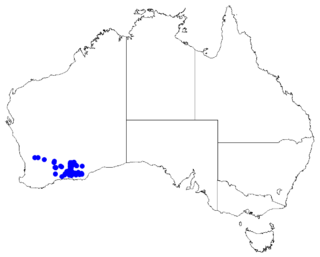
Cyanothamnus fabianoides is a plant in the citrus family, Rutaceae and is endemic to the south-west of Western Australia. It is a compact shrub with many branches, simple, more or less cylindrical leaves and single white, pink or pale blue four-petalled flowers in the leaf axils.
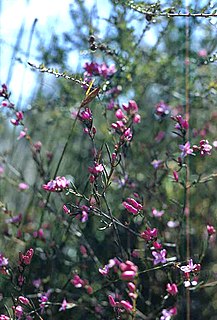
Boronia nematophylla is a plant in the citrus family Rutaceae and is endemic to the south-west of Western Australia. It is a shrub with thin, simple leaves and pale red to purple, four-petalled flowers arranged singly or in small groups in leaf axils.
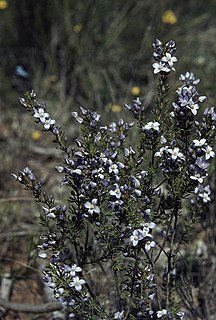
Cyanothamnus ramosus is a species of plant in the citrus family Rutaceae and is endemic to the southwest of Western Australia. It is an erect, mostly glabrous shrub with pinnate leaves with up to seven leaflets, and white, four-petalled flowers with blue or pale green backs.
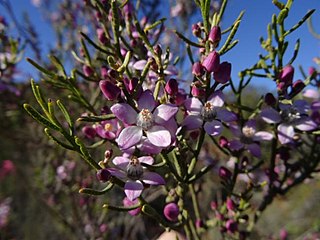
Philotheca brucei is a species of flowering plant in the family Rutaceae and is endemic to Western Australia. It is a shrub with cylindrical leaves grooved along the top and in spring, white to pink or mauve flowers with five egg-shaped petals.

Cyanothamnus subsessilis is a species of plant in the citrus family, Rutaceae and is endemic to the south-west of Western Australia. It is a woody, mostly glabrous shrub with simple leaves and flowers with four petals that are white on the front and green to blue on the back.

Cyanothamnus westringioides is a species of erect shrub that is endemic to a small area in the southwest of Western Australia. It has simple, narrow, sessile leaves and pale pink flowers arranged singly in leaf axils.



















